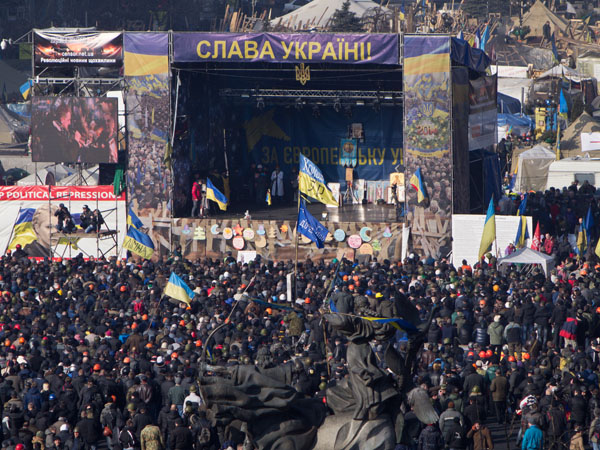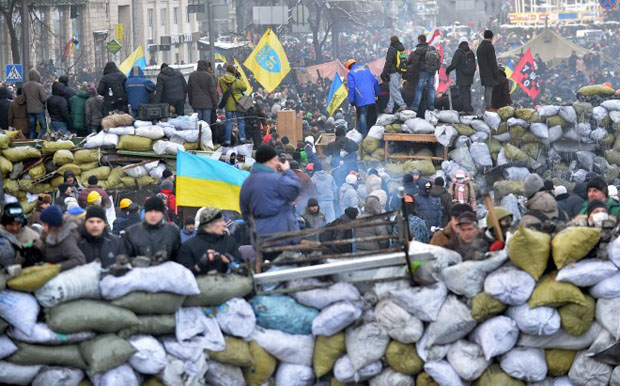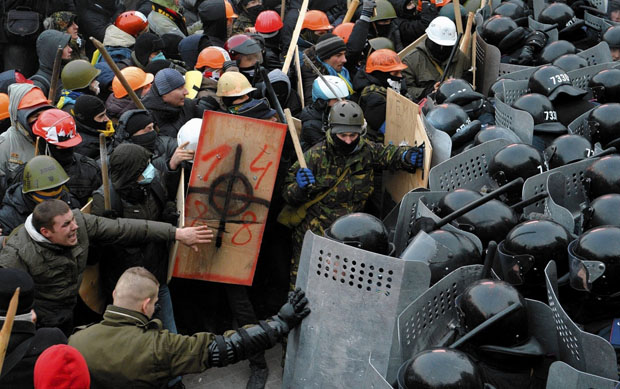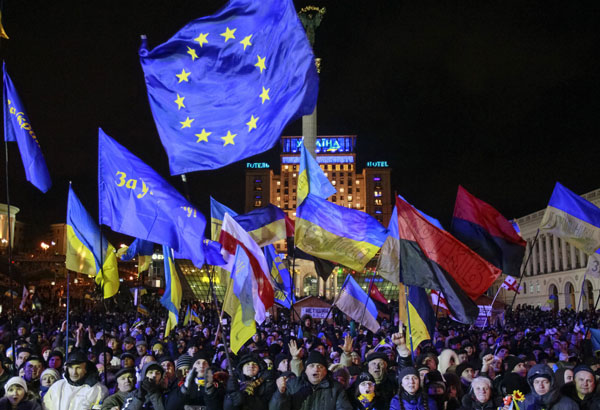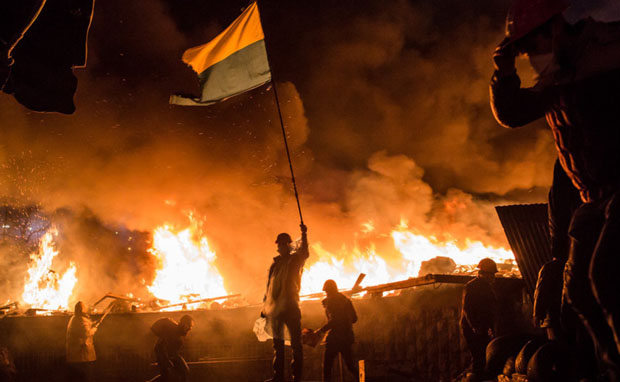Euromaidan Revolution
Euromaidan Revolution or Revolution of Dignity (Євромайдан; Ievromaidan or Революція гідності; Revoliutsiia hidnosti) refers to events in the winter of 2013–14 centered mainly in Kyiv’s Independence Square (Maidan Nezalezhnosti) and featuring sustained, large-scale public protests against the rule of President Viktor Yanukovych resulting in his departure from office, his replacement by Petro Poroshenko, and repeal of his most odious decisions. The second of contemporary Ukraine’s ‘revolutions’ after the Orange Revolution of 2004, it was more violent and more consequential. It evolved from a demonstration against Yanukovych’s act of postponing the signing of an Association Agreement with the European Union into a more general popular uprising against the ruling elite and its corrupt political culture. While Yanukovych was unseated and the decision on the EU soon reversed, the revolution’s broader goals were never fully achieved—much like the promises of the Orange Revolution.
Viktor Yanukovych’s authoritarian rule began in 2010 with his presidential election victory over Yuliia Tymoshenko. He immediately prevailed on the Constitutional Court to rule unconstitutional amendments adopted on 8 December 2004 to the Constitution of Ukraine. This meant reverting from the parliamentary-presidential system of rule under his predecessor, Viktor Yushchenko, to a presidential-parliamentary one, as had existed under Leonid Kuchma. In 2011, he had his challenger in the presidential contest, Tymoshenko, tried and sent to jail. He dealt similarly with others of his Orange Revolution opponents, notably Yurii Lutsenko. The Yanukovych ‘Family’ acquired great wealth derived from political corruption. He consolidated his power by various means, including controlling the Supreme Council of Ukraine and the courts, manipulating the electoral laws and elections themselves, and politicizing the police and the Security Service of Ukraine (SBU).
Negotiations to bring about closer relations between Ukraine and the EU had begun in 1998 and progressed from there. By November 2013, following of two years of preparation, at an EU summit in Vilnius an Association Agreement (AA) and the Deep and Comprehensive Free Trade Agreement (DCFTA) were ready to be signed by the two parties. The aims of these agreements were, respectively, political association and economic integration, and free trade access to the European market as well as increased foreign investment. The Russian Federation, which regards Ukraine as falling within its sphere of influence and thus as a country that should be part of the Russian-controlled Eurasian Economic Union (EAEU), had already imposed import restrictions and rejected negotiations over the price of natural gas. On the eve of the summit Viktor Yanukovych announced postponement of the signing of the two agreements. A fortnight later, Yanukovych and Russian President Vladimir Putin agreed on a 15 billion USD loan to Ukraine, a renegotiated gas price, and lifting of the blockade on Ukrainian exports. Yanukovych’s rationale for postponement was immediate economic necessity.
The mood of the Ukrainian public at this time was particularly sensitive to such a decision, although it was not the details of the AA and DCFTA that were of primary concern. In general, people were very pessimistic about the direction in which their country was going, felt they had no influence on events, distrusted the political establishment, and were ready to protest against the stagnation in their living conditions. For Ukrainians, Europe was not so much a set of values or a model, but merely an aspiration for a normal life where social mobility and a decent standard of living were assured.
On 21 November, in response to the Facebook post by Mustafa Nayyem, a relatively small group of a few thousand students assembled in the Independence Square (Maidan) in advance of the EU summit the following weekend to protest that day’s government announcement of a suspension of the AA process and to urge Ukraine’s adhesion to Europe. Eschewing party symbols, the protest became the nucleus of the ensuing mass demonstration. In the following days, meetings, student strikes, and clashes with police took place adjacent to the Maidan. Similar protests broke out in other large cities. At 4 a.m. on 30 November, in Kyiv Berkut special forces went in to clear the protesters, beating them badly. The disproportionate use of force, caught on camera, shocked the country. A mass rally was called for 1 December, with 700,000 attending, occupying the trade unions building and the city hall. A tent camp and barricades were set up; the Maidan becomes a self-governing entity, with a headquarters, self-defense units organized in companies (sotni, hundreds) modelled on the Zaporozhian Sich, division of labor, and clearly evident order. At 1 a.m. on 11 December, another attempt to clear the square was made by the Berkut, but the standoff lasted for hours as people pushed back with their bodies. Thousands remained on the square; barricades were dismantled and then rebuilt; ordinary citizens came at all hours to help. Catherine Ashton, visiting Kyiv just then as representative of the EU, met with Viktor Yanukovych and leaders of the political opposition. On 13 December, there were round table talks at which the president offered an amnesty for detained demonstrators and identification of those who beat them in the process of dispersal.
The deal with the Russian Federation briefly shifted sentiment in favor of the Yanukovych government, but the beating of journalist and Euromaidan activist Tetiana Chornovol outside Kyiv on 25 December reinvigorated the protest. At the weekly Sunday rally on 29 December, a Manifesto of the Maidan was presented. It called for freedom for the arrested student demonstrators, and sanctions by the international community against Viktor Yanukovych, his ‘Family,’ and associated oligarchs. An Automaidan was organized in which convoys of automobiles supplied the Maidan with food and various necessities, but also paraded to Mezhyhiria to expose the lavish lifestyles of Yanukovych and his associates. Political opposition figures who joined the demonstrators on the Maidan, including Arsenii Yatseniuk, Vitalii Klychko, Oleh Tiahnybok, Petro Poroshenko, and Yurii Lutsenko, demanded Yanukovych’s resignation, early elections, return of the 2004 Constitution, immediate signing of the AA with the EU, and visa-free travel to Europe. Half a million people gathered in the Maidan to celebrate the New Year.
On the part of the government the response throughout was erratic: journalists were targeted; intimidation was attempted through kidnappings and beatings. Provocateurs known as ‘titushky’ were hired and let loose among the demonstrators to discredit them by provoking violence as well as to inflict violence on them. On 16 January, the Supreme Council of Ukraine gave hasty approval to a package of so-called dictatorship laws which prohibited almost everything characteristic of the Maidan as a means of winding down and terminating the protests. Blocking government buildings; wearing face masks or hardhats; setting up tents, stages, and amplifiers without authorization; convoys of more than five cars; slander of government officials; defamation via social media—all were criminalized. Internet-based media and mobile phones were to be registered; externally-funded NGOs became (as in the Russian Federation) ‘foreign agents.’ Foreign governments expressed their dismay at the threat to human rights and civil liberties. The presidential chief of staff, Serhii Liovochkin, resigned in protest and was replaced by Andrii Kliuiev. Most of these laws were later repealed, but their unusually harsh intent at odds with the norms of democratic rights of assembly and expression radicalized the demonstrators encamped in the Maidan. In protest, violent clashes broke out along Hrushevsky Street which resulted in a four-day-long standoff, at least two protesters shot dead, and government buildings occupied. Injured activists who sought hospital treatment were liable to be abducted, beaten, and killed. One who survived was Ihor Lutsenko; others were not so fortunate. In the midst of the rioting President Viktor Yanukovych offered posts in the government—as premier and vice-premier, respectively—to Arsenii Yatsniuk and Vitalii Klychko, who declined. On 28 January, Prime Minister Mykola Azarov resigned by way of defusing the conflict; he fled immediately to Vienna on his Austrian passport and was replaced by Serhii Arbuzov, closely associated with the Yanukovych ‘Family’ as its curator.
A genuine popular uprising erupted in February, the mood of the citizen-protesters having been radicalized by the 16 January laws, the regime’s indiscriminate violence, and the ineffective negotiations engaged in by a duplicitous president and a parliament unrepresentative of the Maidan mood. The protesters became more militant; the authorities, more brutal. On Tuesday, 18 February, what began as a march on parliament turned into a series of running battles between protesters and security forces; the Party of Regions headquarters was set ablaze, perhaps as a provocation; 26 people died, hundreds were injured. The police stormed the Maidan, but managed only to dislodge the protesters occupying the trades union building by setting it on fire. On 20 February, declared as a day of mourning by Yanukovych, clashes resumed as the protesters attempted to make their way up Hrushevsky and Instytutska Streets in the face of sniper fire. In the process, many Berkut personnel were captured or fled, at least seventy protesters were shot dead, some 1,500 people were injured including nearly 200 police, a hundred people went missing, and two snipers were killed. With over one hundred deaths by this time, it had a sobering effect on all concerned.
After a night of tense negotiations an agreement on resolving the crisis was reached on 21 February. On the Ukrainian side were Viktor Yanukovych, Vitalii Klychko, Oleh Tiahnybok, and Arsenii Yatseniuk. The foreign ministers of Poland, Germany, and France—Radosław Sikorski, Frank-Walter Steinmeier, and Laurent Fabius—as well as the Special Envoy for the Russian Federation, Vladimir Lukin, acted as international mediators. It was agreed: to restore the 2004 Constitution; to create a government of national unity; to hold presidential elections no later than December 2014; to form a new Central Election Commission; to investigate recent acts of violence with the Council of Europe monitoring; not to impose a state of emergency; and to end all confrontation and violence. When Klychko announced the agreement on the Maidan he was booed, but its council approved. The Supreme Council of Ukraine voted to reinstate the 2004 Constitution, to suspend Interior Minister Vitalii Zakharchenko as responsible for the slaughter, and to free Yuliia Tymoshenko from prison. Zakharchenko fled to Belarus. The police were withdrawn from central Kyiv. But most measures in the agreement were never implemented.
On the night of 21–22 February Viktor Yanukovych fled, initially to Kharkiv, then to the Crimea, and eventually to the Russian Federation, where a week later he declared himself still to be President of Ukraine. Meanwhile, interpreting his absence as effectively a resignation, the Supreme Council declared him to have abandoned his office and set presidential elections for 25 May 2014. With no constitutional provision dealing with such a contingency, it elected Oleksandr Turchynov as speaker (chair) of the Supreme Council and acting president. On the basis of a coalition between Yuliia Tymoshenko’s Batkivshchyna party and Oleh Tiahnybok’s Svoboda party, supported by Klychko’s UDAR and others, an interim government led by Arsenii Yatseniuk was formed on 27 February. Acting Minister of Interior Arsen Avakov, in charge of the police, promptly dissolved the Berkut division, making culpability for abuse of force more difficult to pursue. Tymoshenko appeared on the stage of the Maidan in a wheelchair, but received a less than enthusiastic response. Funeral services were held for the Heavenly Hundred (Nebesna Sotnia) who had fallen.
Removal of the president, in however accidental and unorthodox a fashion, was one of the very few achieved aims of the Euromaidan Revolution. Reverting to the 2004 Constitution was another. But apart from individuals who fled the country, and there were many, there was no great turnover within the political elite from the old guard to the new as may have been anticipated in a true revolution. The alacrity, often unanimity, with which parliamentarians approved the new government and constitutional order was more like chameleons changing color than a weeding out of the old order. The revolution had no leader and no single Big Idea. Interim education minister Serhii Kvit at the time portrayed the absence of an overall ideology as positive, a manifestation of unity in diversity. Otherwise, there was no road map to guide the caretakers who came to office after the revolution; the only common theme among the protesters was that the president and the government had to resign.
At the same time, the flight of Viktor Yanukovych together with the presence on the Maidan of the militant Right Sector gave rise to a narrative, strongly promoted by the Russian Federation’s government and media, about the Euromaidan Revolution having been a neo-Nazi coup d’êtat. Even some Western sources, including the liberal UK newspaper The Guardian, took up this perspective. This was far from the truth. Yanukovych left the country of his own accord; he was not threatened or in any danger. There were no attempts on his life. There was no dissolution of the Constitution or of its institutions. After his departure, when his tastelessly opulent estate in Mezhyhiria was opened to the public, the citizenry toured the palace and grounds in a respectful if bemused manner. There was no ransacking of revenge-seeking. As to the Right Sector, these militants numbered in the mere hundreds while the overall crowds on the Maidan were in the hundreds of thousands. They were, in fact, minor actors in and late-comers to the action.
Invoking the narrative of the neo-Nazi (or not even neo-) coup along with the supposed repression of ethnic Russians, Vladimir Putin immediately directed the occupation of the Crimea and its annexation into the Russian Federation. He then launched a war in the Donets Basin, labelling it a ‘civil war’ between the authorities in Kyiv and the rebels in the east. This war was real, with tanks, rocket-propelled grenades, and tanks, but the ‘civil’ part of it was fiction. Up to that time there had been no insurgency in Donetsk oblast and Luhansk oblast; the rebels were hastily assembled from a nondescript collection of mercenaries; there was no separatist sentiment in the Donbas—if anything, it was a posture of dependency. If Putin was displeased with Ukraine’s Orange Revolution but chose to bide his time, now he was determined to bring Ukraine by force. This was the major geopolitical consequence of the Euromaidan Revolution.
On 25 May 2014, Petro Poroshenko was elected president with 54.7 per cent of the vote on the first ballot. It would fall to him to implement the more obvious aims of the revolution such as curbing corruption and signing the Association Agreement with the EU. He would also have to re-establish the territorial integrity of Ukraine. The AA was signed with the EU on 27 June and ratified on 16 September; the war in Donbas outlasted his term in office.
On every anniversary since then newspapers in Ukraine feature articles assessing the legacy of the Euromaidan Revolution or Revolution of Dignity, as it has also been called. Whether all that followed the event should be attributable to it, or whether it had clear aims, is questionable, but these assessments agree that the promised and expected changes were not achieved. Scholarly analyses agree. The fact that it continues to be discussed and re-evaluated so long after the event indicates that even as an unachieved revolution the Euromaidan at least (re)awakened the undying hope for a better, more just, political order.
BIBLIOGRAPHY
Wilson, A. Ukraine Crisis: What It Means for the West (New Haven and London 2014)
Harding, L. ‘Kiev’s Protesters: Ukraine Uprising Was No Neo-Nazi Power Grab,’ The Guardian, 13 March 2014
Walker, S.; Amos, H. ‘Ukraine Civil War Fears Mount as Volunteer Units Take Up Arms,’ The Guardian, 15 May 2014
Kvit, S. ‘The Ideology of the Euromaidan Revolution,’ Kyiv Post, 24 March 2014
Bachmann, K.; Lyubashenko, I. (eds). The Maidan Uprising, Separatism and Foreign Intervention: Ukraine’s Complex Transition (Frankfurt am Main 2014)
Popova, M. ‘Why the Orange Revolution Was Short and Peaceful and Euromaidan Long and Violent,’ Problems of Post-Communism, 61, no. 6 (November/December 2014)
Marples, D. R.; Mills, F. V. (eds). Ukraine’s Euromaidan: Analyses of a Civil Revolution (Stuttgart 2015)
Åslund, A. Ukraine: What Went Wrong and How to Fix It (Washington, DC 2015)
Yekelchyk, S. The Conflict in Ukraine: What Everyone Needs to Know (Oxford and New York 2015)
Bertelsen, O. (ed). Revolution and War in Contemporary Ukraine: The Challenge of Change (Stuttgart 2016)
Hale, H. E.; Orttung, R. W. (eds). Beyond the Euromaidan: Comparative Perspectives on Advancing Reform in Ukraine (Stanford 2016)
Reznik, O. ‘From the Orange Revolution to the Revolution of Dignity: Dynamics of the Protest Actions in Ukraine,’ East European Politics and Societies and Cultures, 30, no. 4 (November 2016)
Abelho, S. ‘Yanukovych’s Decision to Postpone the Signature of the Agreement with the EU: A Poliheuristic Analysis,’ JANUS.NET e-journal of International Relations, 8, no. 1 (May-October 2017)
Shore, M. The Ukrainian Night: An Intimate History of Revolution (New Haven and London 2017)
Bennich-Björkman; Kashyn, A.; Kurbatov, S. ‘The Election of a Kleptocrat: Viktor Ianukovych and the Ukrainian Presidential Elections in 2010,’ East/West: Journal of Ukrainian Studies, 6, no. 1 (2019)
Smith, C. Ukraine’s Revolt, Russia’s Revenge (Washington, D.C. 2022)
Bohdan Harasymiw
[This article was written in 2020.]
